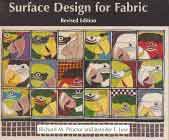ADVERTISEMENT

Richard Proctor and Jennifer Lew's book
Surface Design for Fabric
includes instructions for using Naphthol dyes to dye cotton fabric
ADVERTISEMENT

Richard Proctor and Jennifer Lew's book
Surface Design for Fabric
includes instructions for using Naphthol dyes to dye cotton fabric
Richard Proctor and Jennifer Lew's chart, below, shows how diazo salts can be mixed with naphthol bases to make different colors, from their book, Surface Design for Fabric.
| Base A Naphthol AS | Base B Naphthol AS.G | Base C Naphthol AS.GR | Base D Naphthol AS.LB | Base E Naphthol AS.BO | |
|---|---|---|---|---|---|
| Salt "1" (Fast yellow GC) |
red-orange | pink | red | bright blue | blue-violet |
| Salt "2" (Fast Scarlet R) |
lemon | bright yellow | saffron | gold | ochre |
| Salt "3" (Fast Red B) |
magenta | red-violet | purple | blue-green | green |
| Salt "4" (Fast Blue BB) |
tan | chocolate | red-brown | purple | deep violet |
| Salt "5" (Fast Blue B) |
bright red | deep red | maroon | blue | blue-black |
| chemical | hazards |
|---|---|
| Fast Yellow GC base | tumorigen; mutagen; toxic; dangerous for the environment‡ |
| Fast Blue B diazonium salt | suspected carcinogen; eye irritant; toxic when inhaled or ingested; in solution can be absorbed through the skin*; very toxic** |
| Fast Blue salt R | carcinogen** |
| Fast Red diazonium salt | combustible powder - keep away from heat or naked flame; suspected carcinogen; eye and respiratory tract irritant* |
| Fast Red Salt B diazonium salt | potential carcinogen; irritant to eyes and the respiratory tract*; very toxic** |
| Fast Red Violet diazonium salt | combustible powder - keep away from heat or naked flame; suspected carcinogen; eye and respiratory tract irritant* |
| Fast Ponceau disazo dye | mutagen and a potential carcinogen; highly toxic; skin and eye irritant; must never be handled during pregnancy* |
| Black K salt (Brenthamine K) | may be harmful by inhalation, if swallowed or if absorbed through skin; may cause irreversible effects; irritating to eyes; limited evidence of a carcinogenic effect*** |
| Fast Red A1 salt | may be harmful or act as an irritant; toxicology not fully investigated*** |
Advertisements
All of the pages on this site are copyright ©1998-2025 Paula E. Burch, Ph.D.
Last updated: March 30, 2016
Page created: May 7, 2005
Downloaded: Tuesday, December 09, 2025